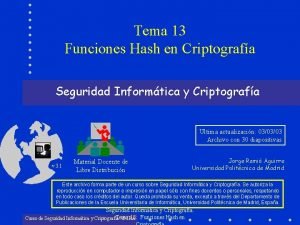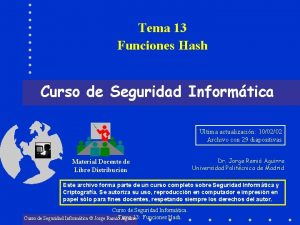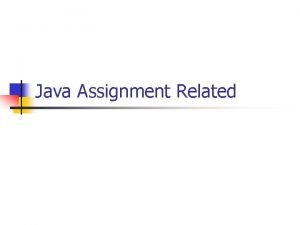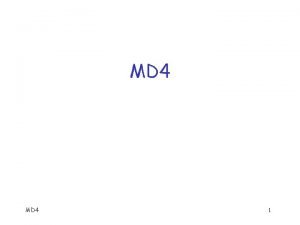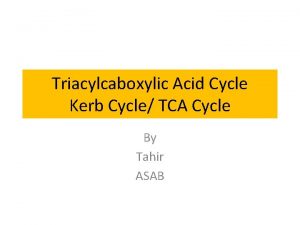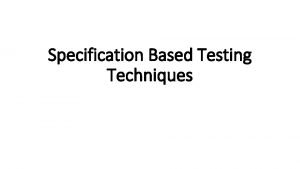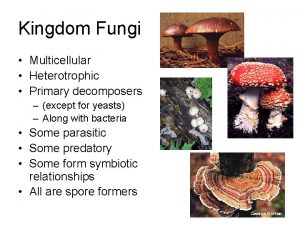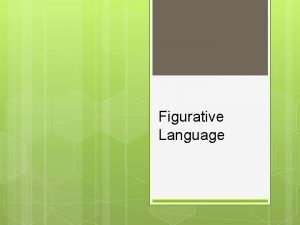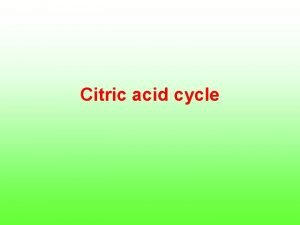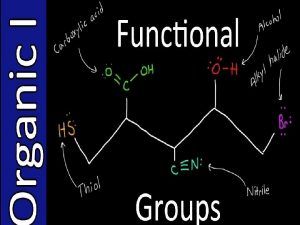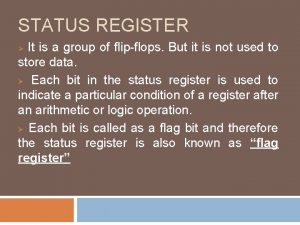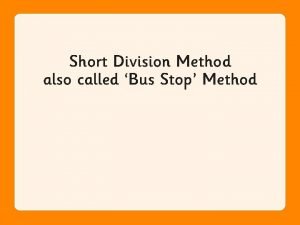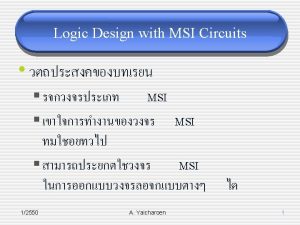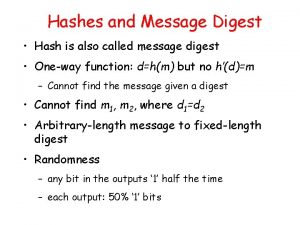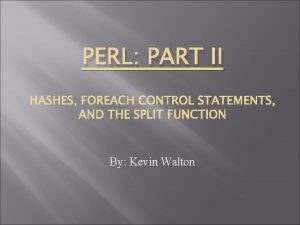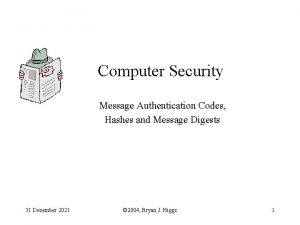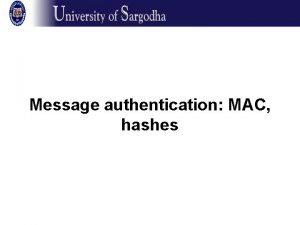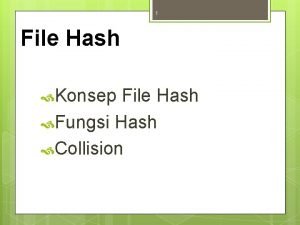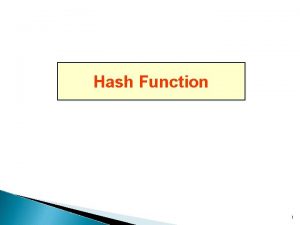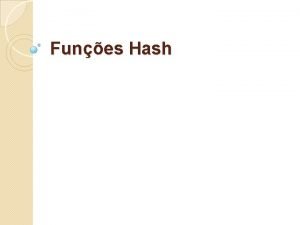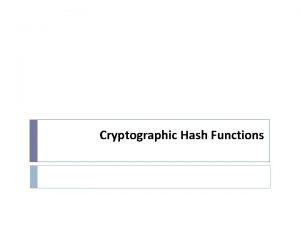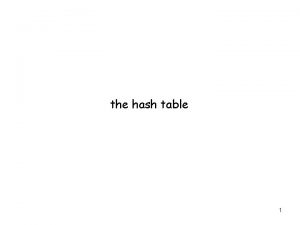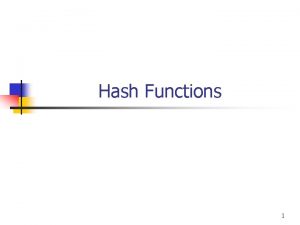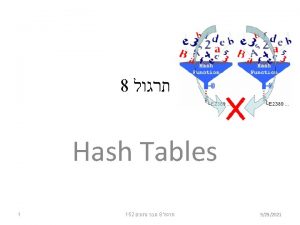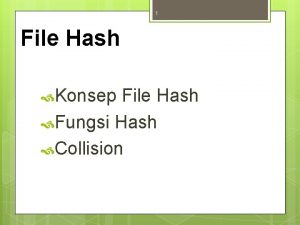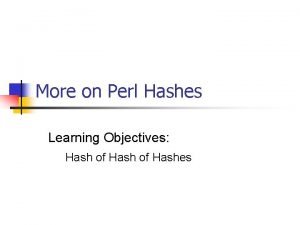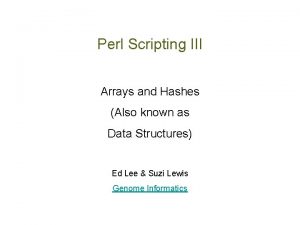Hashes and Message Digest Hash is also called























- Slides: 23

Hashes and Message Digest • Hash is also called message digest • One-way function: d=h(m) but no h’(d)=m – Cannot find the message given a digest • Cannot find m 1, m 2, where d 1=d 2 • Arbitrary-length message to fixed-length digest • Randomness – any bit in the outputs ‘ 1’ half the time – each output: 50% ‘ 1’ bits

Birthday Problem • How many people do you need so that the probability of having two of them share the same birthday is > 50% ? • Random sample of n birthdays (input) taken from k (365, output) • kn total number of possibilities • (k)n=k(k-1)…(k-n+1) possibilities without duplicate birthday • Probability of no repetition: – p = (k)n/kn 1 - n(n-1)/2 k • For k=366, minimum n = 23 • n(n-1)/2 pairs, each pair has a probability 1/k of having the same output • n(n-1)/2 k > 50% n>k 1/2

How Many Bits for Hash? • m bits, takes 2 m/2 to find two with the same hash • 64 bits, takes 232 messages to search (doable) • Need at least 128 bits

Using Hash for Authentication • Alice to Bob: challenge r. A • Bob to Alice: MD(KAB|r. A) • Bob to Alice: r. B • Alice to Bob: MD(KAB|r. B) • Only need to compare MD results

Using Hash to Encrypt • One-time pad with KAB – Compute bit streams using MD, and K • b 1=MD(KAB), bi=MD(KAB|bi-1), … – with message blocks – Add a random 64 bit number (aka IV) b 1=MD(KAB|IV), bi=MD(KAB|bi-1), …

General Structure of Secure Hash Code • Iterative compression function – Each f is collision-resistant, so is the resulting hashing

MD 5: Message Digest Version 5 input Message Output 128 bits Digest • Until recently the most widely used hash algorithm – in recent times have both brute-force & cryptanalytic concerns • Specified as Internet standard RFC 1321

MD 5 Overview

MD 5 Overview 1. Pad message so its length is 448 mod 512 2. Append a 64 -bit original length value to message 3. Initialise 4 -word (128 -bit) MD buffer (A, B, C, D) 4. Process message in 16 -word (512 -bit) blocks: – Using 4 rounds of 16 bit operations on message block & buffer – Add output to buffer input to form new buffer value 5. Output hash value is the final buffer value

Padding Twist • Given original message M, add padding bits “ 10*” such that resulting length is 64 bits less than a multiple of 512 bits. • Append (original length in bits mod 264), represented in 64 bits to the padded message • Final message is chopped 512 bits a block

MD 5 Process • As many stages as the number of 512 -bit blocks in the final padded message • Digest: 4 32 -bit words: MD=A|B|C|D • Every message block contains 16 32 -bit words: m 0|m 1|m 2…|m 15 – Digest MD 0 initialized to: A=01234567, B=89 abcdef, C=fedcba 98, D=76543210 – Every stage consists of 4 passes over the message block, each modifying MD • Each block 4 rounds, each round 16 steps

Processing of Block mi - 4 Passes mi MDi ABCD=f. F(ABCD, mi, T[1. . 16]) A C B D ABCD=f. G(ABCD, mi, T[17. . 32]) ABCD=f. H(ABCD, mi, T[33. . 48]) ABCD=f. I(ABCD, mi, T[49. . 64]) + MD i+1 + + +

Different Passes. . . Each step t (0 <= t <= 79): • Input: – mt – a 32 -bit word from the message With different shift every round – Tt – int(232 * abs(sin(i))), 0<i<65 Provided a randomized set of 32 -bit patterns, which eliminate any regularities in the input data – ABCD: current MD • Output: – ABCD: new MD

MD 5 Compression Function • Each round has 16 steps of the form: a = b+((a+g(b, c, d)+X[k]+T[i])<<<s) • a, b, c, d refer to the 4 words of the buffer, but used in varying permutations – note this updates 1 word only of the buffer – after 16 steps each word is updated 4 times • where g(b, c, d) is a different nonlinear function in each round (F, G, H, I)

MD 5 Compression Function

Functions and Random Numbers • F(x, y, z) == (x y) (~x z) – selection function • G(x, y, z) == (x z) (y ~ z) • H(x, y, z) == x y z • I(x, y, z) == y (x ~z)

Secure Hash Algorithm • Developed by NIST, specified in the Secure Hash Standard (SHS, FIPS Pub 180), 1993 • SHA is specified as the hash algorithm in the Digital Signature Standard (DSS), NIST

General Logic • Input message must be < 264 bits – not really a problem • Message is processed in 512 -bit blocks sequentially • Message digest is 160 bits • SHA design is similar to MD 5, but a lot stronger

Basic Steps Step 1: Padding Step 2: Appending length as 64 bit unsigned Step 3: Initialize MD buffer 5 32 -bit words Store in big endian format, most significant bit in low address A|B|C|D|E A = 67452301 B = efcdab 89 C = 98 badcfe D = 10325476 E = c 3 d 2 e 1 f 0

Basic Steps. . . Step 4: the 80 -step processing of 512 -bit blocks – 4 rounds, 20 steps each. Each step t (0 <= t <= 79): – Input: • Wt – a 32 -bit word from the message • Kt – a constant. • ABCDE: current MD. – Output: • ABCDE: new MD.

Basic Steps. . . • Only 4 per-round distinctive additive constants 0 <=t<= 19 Kt = 5 A 827999 20<=t<=39 Kt = 6 ED 9 EBA 1 40<=t<=59 Kt = 8 F 1 BBCDC 60<=t<=79 Kt = CA 62 C 1 D 6

SHA-1 verses MD 5 • Brute force attack is harder (160 vs 128 bits for MD 5) • Not vulnerable to any known cryptanalytic attacks (compared to MD 4/5) • A little slower than MD 5 (80 vs 64 steps) – Both work well on a 32 -bit architecture • Both designed as simple and compact for implementation

Revised Secure Hash Standard • NIST have issued a revision FIPS 180 -2 • adds 3 additional hash algorithms • SHA-256, SHA-384, SHA-512 • designed for compatibility with increased security provided by the AES cipher • structure & detail is similar to SHA-1 • hence analysis should be similar
 Tema de hash hash
Tema de hash hash Algoritmo abcde
Algoritmo abcde Message digest java
Message digest java Message digest 4
Message digest 4 Message signature hash
Message signature hash What does shark skin feel like
What does shark skin feel like Uninformed search is also called as
Uninformed search is also called as How is citric acid cycle regulated
How is citric acid cycle regulated Specifcation based techniques are also called as
Specifcation based techniques are also called as Trachea is also called
Trachea is also called A workbook is also called a
A workbook is also called a Multicellular heterotrophs
Multicellular heterotrophs Formal spectacles
Formal spectacles It is also called figurative language
It is also called figurative language What is a gliding vowel
What is a gliding vowel Citric acid cycle definition
Citric acid cycle definition What is axial movement
What is axial movement Alkanes list
Alkanes list Register is a group of
Register is a group of Bus stop division
Bus stop division Womb is also called
Womb is also called Random scan display in computer graphics
Random scan display in computer graphics Data selector is also called
Data selector is also called A pie diagram is also called
A pie diagram is also called
